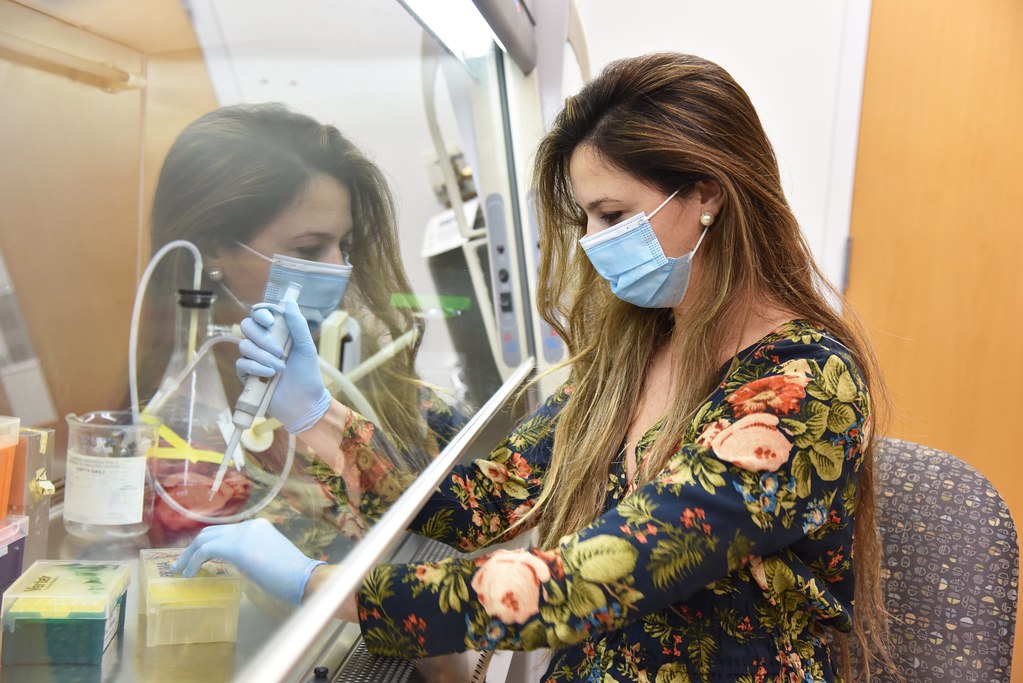Imbalance in research is steep, but visibility and confidence key factors for women

By Lauren Hines | Bond LSC
Victoria Calzada was in the corner of the Donald Burke-Agüero lab, focused on her computer when she missed an important call.
Eventually, she stood up from her bench and listened to the voicemail. She had won the 2020 L’Oréal-United Nations Educational Science and Cultural Organization (UNESCO) Women in Science award for her country, Uruguay.
“It was very exciting,” Calzada said. “I had to cry.”
Calzada is an assistant professor visiting the Burke lab from the University of the Republic in Uruguay. Arriving in March 2020 specifically to work with the aptamer expertise of the Burke lab, this makes it her longest visit to the United States.
While many women like Calzada make strides in science, a steep imbalance of women in research exists. According to the UNESCO Institute for Statistics, fewer than 30% of researchers around the globe and only 3% of Nobel Prize winners are women.
“In my country, for example, I think we need to work better on [this inequality] because just to say that something is wrong is not enough,” Calzada said. “I think [in the U.S.], you have a lot of things you have been working on about that, but we have to keep working because the [inequality] is here.”
The American Association of University Women sees the “confidence gap” as one of the main reasons this imbalance exists. The confidence gap is how girls are discouraged from STEM areas, lose confidence, and therefore, interest in STEM at an early age. AAUW identified gender stereotypes, male-dominated cultures and a lack of role models to also be contributing factors.
“This type of visibility helps encourage and inspire younger women who go into these fields,” said Thomas Quinn, biochemistry professor and director of the Molecular Interactions Core at Mizzou. “I think that’s really important for these types of awards to help stimulate and inspire the next generations to go into research and help erase those disparities. I think Victoria is a great example. It’s going to take effort on all our parts to overcome that.”
Quinn was Calzada’s mentor when she was working on her master’s thesis in 2008. In 2011, the two worked on ways to label biomolecules by attaching a radioactive element to those molecules as a tracker or using fluorescent dye on the molecules. These experiences have led Calzada to carve out her own area of aptamer research.
“This is the feature I want to research. I think aptamers have very clear potential in this area, in radiopharmacy, and in therapy. I was very interested about that.”
Calzada came to the Burke lab to further study aptamers, which are small DNA or RNA nucleic acids that can bind to certain molecular targets like puzzle pieces. Calzada wants to use these aptamers to find molecules that are in breast cancer, which can serve as a diagnostic. A therapeutic can also be attached to these aptamers and be delivered to cancer cells as it moves through the body. This research grabbed the attention of L’Oréal and UNESCO.
“Nucleic acids are just fundamentally different molecules, and so it’s a bigger challenge,” Quinn said. “That’s why it takes someone like Victoria to carve out this niche and assemble people who are experts in aptamers to collaborate…. I really think that she’ll be the one to make a big advance here.”
The UNESCO Institute for Statistics also explores other factors ranging from educational pathways to social factors, such as the challenges that come with starting a family.
Biochemist María Fernanda García works in molecular imaging and radiopharmacy at the University of the Republic and is a mom. García has known Calzada since they went to school together at the university in Uruguay.
“As women, in the last century we have had to work for more opportunities and visibility,” said García. “Historically, the job of women was taking care of the family. That is a job most women still do, but nowadays women have developed a path in different careers and over time more women are reaching for more positions and showing men and women are able to do the same things.”
When Garcia first had her son, the university allowed her to work less with flexible hours, as part of their support for new mothers.
“It’s also possible that women in science can have a family,” García said. “It will be easier if society can support them, or institutions support them. So, if there are policies that encourage or give you the support, women won’t have to choose between science and family or another profession.”
According to the MU New Employee 2017 Orientation presentation, Mizzou offers 12 weeks of unpaid parental or medical leave for its employees as long as they have been employed for at least one year and have worked 1,250 hours within the previous 12-months.
Mizzou’s Graduate School also has an extensive list of assistance and accommodation options for full-time graduate students experiencing pregnancy-related conditions and/or parenting.
Mizzou also provides lactation stations in certain buildings on campus in addition to maternal programs with MU Health Care.
While the path to shrinking this gap is long, increasing the visibility of women in science and increasing STEM confidence in young women are vital next steps.
“We grow up thinking we cannot do the same things as a man,” Calzada said. “I think we have to understand this is wrong and be conscious that we can get the same things in life. When we understand that, I think we feel more encouraged to work in different things like research.”
Calzada’s award came from the L’Oréal-UNESCO For Women in Science Program

